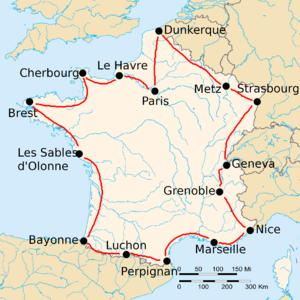1919 Tour de France

Route of the 1919 Tour de France
Followed counterclockwise, starting in Paris |
|||||||||||||
| Race details | |||||||||||||
|---|---|---|---|---|---|---|---|---|---|---|---|---|---|
| Dates | 29 June – 27 July | ||||||||||||
| Stages | 15 | ||||||||||||
| Distance | 5,560 km (3,455 mi) | ||||||||||||
| Winning time | 231h 07' 15" | ||||||||||||
| Results | |||||||||||||
|
|||||||||||||
| Winner |
|
(Category A) | |
| Second |
|
(Category A) | |
| Third |
|
(Category A) |
The 1919 Tour de France was the 13th edition of the Tour de France, taking place from 29 June to 27 July over a total distance of 5,560 kilometres (3,450 mi). It was the first Tour de France after World War I, and was won by Firmin Lambot. In the eleventh stage, the yellow jersey, given to the leader of the general classification, was introduced, and first worn by Eugène Christophe.
The fighting in World War I had ravaged the French road system, which made cycling difficult. As a result, the average speed (24.056 km/h) and the number of finishing cyclists (ten) were the lowest in history.
Since the previous Tour de France in 1914, it was impossible to organise the Tour de France due to World War I. Tour organiser Henri Desgrange always wanted to organise a new Tour after the war, and within days after the end of the war, the organisation of the 1919 Tour de France started.
Three former winners of the Tour, François Faber, Octave Lapize and Lucien Petit-Breton had died fighting in the war. Two other former winners, Philippe Thys and Odile Defraye started the race. The war had been only over for seven months, so most cyclists did not have a chance to train enough for the Tour. For that reason, there were almost no new younger cyclists, and the older cyclists dominated the race. The organisation did not make it easy for the cyclists: with 5560 km it was longer than all the previous Tours, and since then only the 1926 Tour de France has been longer.
The bicycle manufacturers had also suffered from the war, and were unable to sponsor teams of cyclists. They worked together, and sponsored more than half of the cyclists under the name "La Sportive", but effectively all the cyclists rode as individuals. Cyclists were divided in an A-category (professional) and a B-category (amateurs).
...
Wikipedia
